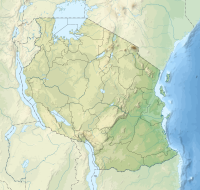Kendwa Island
Appearance
| Kendwa Island | |
|---|---|
| Location | Dar es Salaam Region, Kigamboni District |
| Nearest city | Dar es Salaam |
| Coordinates | 6°47′56″S39°19′51″E/ 6.79889°S 39.33083°E |
| Area | 5.30km² |
| Established | March 2007 |
| Governing body | Marine Parks & Reserves Authority (Tanzania) |
| Website | DMRS |
Kendwa Island(Kisiwa cha Kendwa,inSwahili) is a protected, uninhabited island in theSea of Zanjunder theDar es Salaam Marine Reserve(DMRS) with theIUCN category IIlocated withinKigamboni DistrictofDar es Salaam RegioninTanzania.[1]The islands reserve measures around 5.30km2. TheSinda Islandis to the east of the island, theMakatumbi Islandsare to the north, and theKigamboniward of Kigamboni is to the west.[2][3][4][5][6]The island is home to endangeredcoconunt crabs.[7]
See also
[edit]References
[edit]- ^"Old German Map of Dar es Salaam".Retrieved2023-09-10.
- ^"Marine Parks and Marine Reserves of Tanzania".Retrieved2020-09-07.
- ^Levine, Arielle. (2010). Local Responses to Marine Conservation in Zanzibar, Tanzania. Journal of International Wildlife Law and Policy. July–December 2004. 183-202. 10.1080/13880290490883241
- ^Okera, W. "The zooplankton of the inshore waters of Dar es Salaam (Tanzania, SE Africa) with observations on reactions to artificial light." Marine Biology 26 (1974): 13-25.
- ^Jones, D. A. “New Isopods of the Genus Lanocira (Corallanidae) from the Indian Ocean Region.” Crustaceana, vol. 42, no. 1, 1982, pp. 65–75. JSTOR,http://www.jstor.org/stable/20103693.Accessed 10 Sept. 2023.
- ^Hoyle, B. S. “African Politics and Port Expansion at Dar Es Salaam.” Geographical Review, vol. 68, no. 1, 1978, pp. 31–50. JSTOR,https://doi.org/10.2307/213509.Accessed 10 Sept. 2023.
- ^Caro, Tim, et al. "A case study of the coconut crab Birgus latro on Zanzibar highlights global threats and conservation solutions." Oryx 55.4 (2021): 556-563.

